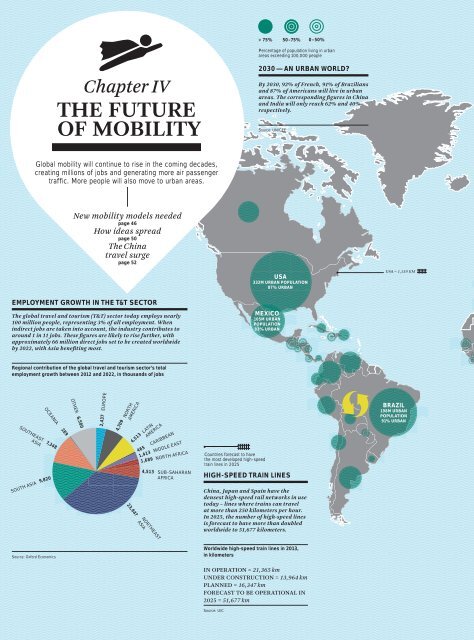New Mobility
Easing global gridlock Global Investor, 02/2013 Credit Suisse
Easing global gridlock
Global Investor, 02/2013
Credit Suisse
You also want an ePaper? Increase the reach of your titles
YUMPU automatically turns print PDFs into web optimized ePapers that Google loves.
75% 50–75% 0–50%<br />
Percentage of population living in urban<br />
areas exceeding 100,000 people<br />
Chapter IV<br />
THE FUTURE<br />
OF MOBILITY<br />
2030 — AN URBAN WORLD?<br />
By 2030, 92% of French, 91% of Brazilians<br />
and 87% of Americans will live in urban<br />
areas. The corresponding figures in China<br />
and India will only reach 62% and 40%<br />
respectively.<br />
Source: UNICEF<br />
Global mobility will continue to rise in the coming decades,<br />
creating millions of jobs and generating more air passenger<br />
traffic. More people will also move to urban areas.<br />
<strong>New</strong> mobility models needed<br />
page 46<br />
How ideas spread<br />
page 50<br />
The China<br />
travel surge<br />
page 52<br />
EMPLOYMENT GROWTH IN THE T&T SECTOR<br />
The global travel and tourism (T&T) sector today employs nearly<br />
100 million people, representing 3% of all employment. When<br />
indirect jobs are taken into account, the industry contributes to<br />
around 1 in 11 jobs. These figures are likely to rise further, with<br />
approximately 66 million direct jobs set to be created worldwide<br />
by 2022, with Asia benefiting most.<br />
USA<br />
332M URBAN POPULATION<br />
87% URBAN<br />
MEXICO<br />
105M URBAN<br />
POPULATION<br />
83% URBAN<br />
USA = 1,139 KM<br />
Regional contribution of the global travel and tourism sector’s total<br />
employment growth between 2012 and 2022, in thousands of jobs<br />
SOUTHEAST<br />
ASIA<br />
SOUTH ASIA<br />
OCEANIA 289<br />
7,348<br />
9,820<br />
OTHER<br />
6,580<br />
EUROPE<br />
2,437<br />
4,709<br />
NORTH<br />
AMERICA<br />
23,947<br />
4,513<br />
465<br />
1,413<br />
4,513<br />
NORTHEAST<br />
ASIA<br />
LATIN<br />
AMERICA<br />
1,689<br />
CARIBBEAN<br />
MIDDLE EAST<br />
NORTH AFRICA<br />
SUB-SAHARAN<br />
AFRICA<br />
Countries forecast to have<br />
the most developed high-speed<br />
train lines in 2025<br />
HIGH-SPEED TRAIN LINES<br />
China, Japan and Spain have the<br />
densest high-speed rail networks in use<br />
today – lines where trains can travel<br />
at more than 250 kilometers per hour.<br />
In 2025, the number of high-speed lines<br />
is forecast to have more than doubled<br />
worldwide to 51,677 kilometers.<br />
BRAZIL<br />
198M URBAN<br />
POPULATION<br />
91% URBAN<br />
Source: Oxford Economics<br />
Worldwide high-speed train lines in 2013,<br />
in kilometers<br />
IN OPERATION = 21,365 km<br />
UNDER CONSTRUCTION = 13,964 km<br />
PLANNED = 16,347 km<br />
FORECAST TO BE OPERATIONAL IN<br />
2025 = 51,677 km<br />
Source: UIC

















